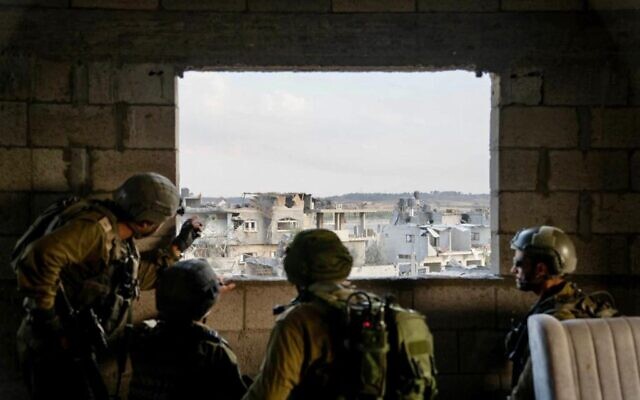
Israeli soldiers operate inside the Gaza Strip, November 2, 2023. (Israel Defense Forces), via Times of Israel.
Latest developments
- Nearly three weeks after the savage Hamas terror attacks left more than 1,400 people murdered, more than 5,000 wounded, and at least 240 abducted, Israel’s war against Hamas has now entered its second stage, with a ground operation that began on 28 October.
- Israeli tanks and infantry are advancing around Gaza City in the northern Gaza City, backed by airstrikes and artillery. The IDF has increased the urgency of its calls for Gazan civilians to head south away from Gaza city, with Hamas acting to prevent people from leaving. As of today, Israel reported the loss of 18 soldiers in the ground operation.
- Hamas leaders threatened a repeat of the 7 October atrocities. “We must teach Israel a lesson, and we will do it twice and three times. The Al-Aqsa Deluge [the name Hamas gave its October 7 onslaught] is just the first time, and there will be a second, a third, a fourth,” Ghazi Hamad, a senior member of Hamas’ political bureau, told Lebanese television. “Will we have to pay a price? Yes, and we are ready to pay it. We are called a nation of martyrs, and we are proud to sacrifice martyrs.” Hamad added that Israel’s existence is “illogical” and that it must be wiped off all “Palestinian lands,” a term the terror group uses to mean the West Bank, Gaza and Israel, minus the Golan Heights.
- Israel’s focus in the military operation has been the network of hundreds of miles of underground concrete tunnels and bunkers built by Hamas under Gaza’s population centres.
- The IDF targeted a stronghold in the area of Jabaliya on the outskirts of Gaza City with heavy airstrikes on Tuesday and Wednesday, killing Hamas terrorists including Central Jabaliya brigade commander Ibrahim Biari, one of the leaders of the 7 October attack. The strikes caused massive destruction to homes and other civilian infrastructure under which the tunnels are built, with a significant number of civilian casualties. Israel is calling on Palestinians to evacuate the Al Shifa hospital – the largest in Gaza City – and has released graphics showing a sophisticated Hamas tunnel network underneath Al Shifa and other hospitals.
- Since 7 October, Hamas and other armed groups have continued to fire rockets at southern and central Israel. Around 8,500 had been fired as of Tuesday, with around 10 percent falling short inside the Gaza Strip or in the sea.
- As of Thursday, the Hamas-run health ministry in Gaza claimed that there had been 9,061 Palestinian fatalities, though the number cannot be independently verified, nor the proportion of Palestinian casualties that are civilians.
- Hezbollah attacks across Israel’s northern border from south Lebanon have continued, with daily anti-tank missile, rocket and mortar attacks. Israel has responded with airstrikes against Hezbollah infrastructure. For now, the level of fire across this front has remained contained, and Israel has kept to a policy of responding to Hezbollah fire, and seeking to avoid escalation. However, the risk of escalation on this front, either because of an Iranian or Hezbollah decision to escalate, or accident or miscalculation, remains high.
- There have been further attempted attacks by Iranian-backed Houthi armed groups in Yemen, with a drone and surface to surface missile fired in the direction of Eilat on Tuesday and intercepted by the IDF.
- Freeing hostages, including women and more than 30 children, remains a major focus for Israel and the international community. In a military operation early on Monday, 19-year-old female Israeli soldier Ori Megidish became the first Israeli hostage to be rescued from inside the Gaza Strip. Hamas issued a hostage video on Monday that showed three Israeli women, and a statement by Hamas spokesman Hazem Qassem the same day suggested Hamas would release all the hostages in return for the release of all Palestinian prisoners. This received some interest in Israel but was rejected by Israeli defence minister Yoav Galant as “psychological games”. A Hamas spokesman said in a separate statement on Tuesday that a “certain number of foreigners” would be released in the coming days. Up to seven British nationals still missing may be among the hostages. So far, four hostages have been released by Hamas.
- Humanitarian access through the Egypt-Gaza Rafah crossing is expanding gradually. On Tuesday, Israel agreed to allow 100 trucks of humanitarian aid into Gaza each day. The actual number to enter on Tuesday was 59 trucks, carrying water, food and medicines, a significant increase on previous days. On Wednesday, Egypt opened its border with Gaza to allow dual nationals to leave and a small number of wounded Palestinians to be treated in Egyptian hospitals. On Sunday, Israel reopened the second of three water pipelines that provide water to the Gaza Strip, now allowing for a total of some 28.5 million litres per day to flow.
- US secretary of state Antony Blinken has made clear the Biden administration’s view that a “revitalised” Palestinian Authority should resume control of Gaza once Israel has succeeded in toppling Hamas, with regional partners and international agencies playing a transitional role. This would see the Palestinian territories reunified under the PA for the first time since 2007.
- In a video post on Monday, Israel Labor party leader Merav Michaeli joined calls for prime minister Benjamin Netanyahu to resign immediately, saying: “In such a state of no confidence, Netanyahu must be replaced now.” Her call followed an incident on Sunday in which a statement tweeted in Netanyahu’s name foisted responsibility for 7 October failings onto intelligence chiefs. Following a backlash, including from emergency war cabinet member Benny Gantz, Netanyahu issued an apology.
The coming days
- Israel’s ground operation is expected to continue to advance around the centre of Hamas’s operation in central Gaza City. Engagements with Hamas fighters are likely to increase, along with the exposure of IDF forces and associated Israeli military casualties. Israel will continue to use heavy air power and artillery to target underground Hamas forces and commanders, many of whom are intentionally hiding in dense urban areas, causing further harm to civilians.
- Pressure will continue to mount on Israel to increase humanitarian supplies and access, avoid harm to civilians, and to allow for humanitarian pauses or a ceasefire. Israel is highly unlikely to agree to any ceasefire, but is likely to continue to agree to further humanitarian steps to reduce the impact on Gazan civilians and respond to international pressure. Egypt may expand access to its territory from Gaza, including the possibility of establishing a field hospital on its side of the border.
- The risk of the conflict broadening into a regional conflict remains ever-present with respect to the involvement of Hezbollah, Houthis in Yemen, and an escalation of violence in the West Bank.
In the UK
- On Tuesday, labour leader Keir Starmer set out his support for “pauses in the fighting for clear and specific humanitarian purposes” in Gaza – in line with the position of the Biden administration – explaining that calls for a ceasefire would “embolden” Hamas and leave the terror group with the capacity to carry out further attacks on Israel, as well as preventing the return of hostages.
- The UK has seen a huge jump in antisemitic incidents since Hamas’s initial attacks, with at least 893 antisemitic incidents across the UK between 7 and 31 October, many involving “symbols and language of pro-Palestinian politics as rhetorical weapons”, the Community Security Trust reports. This is the highest-ever total reported to the CST over the same period.
- Eleven people were arrested last weekend following pro-Palestinian protests in London. At the ‘March for Palestine’ on Saturday, the Metropolitan Police Force arrested a total of nine people – two on suspicion of assaulting police officers and seven for public order offences. The police said the demonstration saw “pockets of disorder and some instances of hate speech”.


